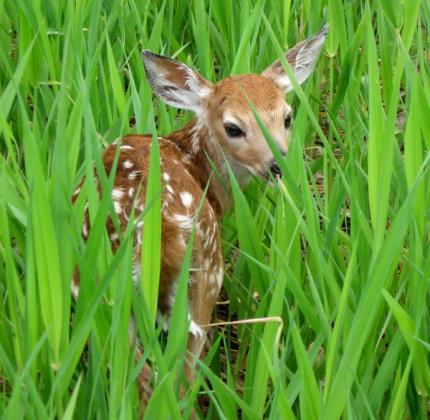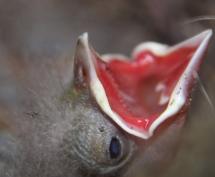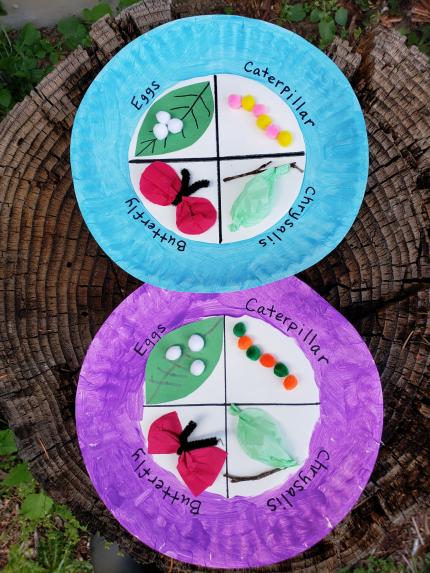
When we find a baby wild animal, our first instinct is often to try and rescue it, especially if it's alone. But, just because baby animals are alone does not mean they need your help. Check out the lessons below to learn what to do if you find a baby animal in the wild.
Animals also grow up in different ways. Some baby animals look like mini versions of their parents, while others go through unique life cycles. Learn about life cycles of butterflies, salmon, and Pacific lamprey in the lessons below.
Materials
- Baby wildlife memory game (PDF)
- Salmon life cycle board game (PDF) (Courtesy of Power Smart for Schools)
- Pacific lamprey activity book (PDF) (Courtesy of U.S. Fish and Wildlife Service)
Bird eggs and nests
Just like people's houses, bird nests come in variety of shapes and sizes. Some birds are larger and need bigger nests, while others need to hide their young from predators. Birds build nests to hold their eggs and baby birds after they've hatched. Because of this, birds build their nests to provide three things: camouflage, shelter, and safety. Birds often make their nests out of materials that are nearby to help them blend into their surroundings. By using bits of leaves, grass, moss, or animal fur, bird nests are cushioned to keep eggs from breaking.
Watch this hummingbird build its nest, and answer the following questions:
- What body parts does it use?
- What materials are used to make the nest?
- Where did the hummingbird build the nest? Why?
Now that you've learned how a nest is made, explore how an egg hatches into a bird.
Activity: Make your own bird nest
Fly around like a bird outside and find things you can use to build your own bird nest! Watch this short video for guidance on collecting materials outside and using your own supplies to make your nest unique.
Gather your materials
- Bag or bucket to collect natural materials
- Sticks, twigs, leaves, bark, etc. from outside
- Glue (or mud)
- Eggs or small rocks you can pretend are eggs
- Shredded paper, pipe cleaners, tissue paper (Optional)
Instructions
- This activity can be messy, so work outside if possible. If you need to stay inside, build your nest on a tray for easier clean up.
- Go outside and see if you can find any bird nests. If you find one, observe it carefully from a distance. Can you tell what materials the nest is made of? If you can't find any bird nests outside, look at different types of bird nests online at nestwatch.org.
- Look around outside for materials you can pick up easily, like twigs and rocks. Use your bucket or bag to gather materials.
- Use your materials to build a nest that can safely hold at least one egg. Make your nest unique, just like you!
- Test your nest. Does the nest fall apart easily? Can you blow on it, pick it up, and place an egg inside it? If not, what can you do it make it sturdier?
Keep baby wildlife wild
It is natural to want to help if you discover a baby bird on the ground or a deer fawn alone in the forest. But most times, it is better to leave it alone.
Deer fawns
Most fawns are not abandoned or orphaned. Rather, their mothers are likely nearby foraging for food or resting. Fawns are born without scent, so if they remain very still, they do not attract predators. The mother deer may only return at dawn and dusk to feed her fawn. In fact, fawns instinctively lie low while waiting for their mother to return. In many cases, a doe may leave her fawn in the same spot for several days until it is strong enough to move with her. Only contact a permitted wildlife rehabilitator if the mother does not return or if the fawn appears weak, ill, or injured.
Baby birds

If you come across a baby bird on the ground, it's best not to interfere. Fledglings (partially feathered birds) typically leave the nest and move on the ground and low branches for a few days before they can fly. During this time, their parents are nearby and continue to care for them. Unless injured, a fledgling bird should be left where it is. You can help by keeping cats and dogs away from the bird so that it stays safe while the mother can continue to feed it.
If you find a baby bird that doesn't have feathers yet, it is a nestling that has likely fallen or been pushed from a nearby nest. If you can find the nest, you can give the bird a helping hand by returning the chick to the nest. Make sure to go with an adult and wear gloves.
Learn more on our blog, Spring babies - do they need your help?.
Activity: Baby wildlife memory game
Do you know what different baby wildlife are called? Learn which Washington wildlife call their young pups, kits, cubs, and kids.
Gather your materials
- Baby wildlife memory game (PDF)
- Scissors
Instructions
- Print out the baby wildlife memory game and cut apart the different animal cards.
- Mix up the cards and lay them face down on a table.
- Turn over any two cards. If the two cards match (parent and baby), keep them. If they don't match, turn them back over.
- Remember what was on each card and where it was.
- Take turns if you are playing with others. Watch and remember during the other player's turn.
- Keep playing until all the cards have been matched. The person with the most matches wins.
Activity: Watch bird nests live
Get up close and personal with live nest cameras! These live feeds give us a glimpse of what's happening inside bird nests.
Butterfly metamorphosis
Butterflies aren't born with wings. Instead, they go through a process called metamorphosis to change from a caterpillar to a chrysalis to an adult butterfly.
Watch this 4-minute video to learn why the very hungry caterpillar is so hungry!
Activity: Design your own butterfly life cycle

Metamorphosis includes four life stages: egg, larva, pupa, and adult. Put your art skills to the test and make your own butterfly life cycle!
Gather your materials
- White paper plate
- Green construction paper
- Small white poms poms or a cotton ball
- 6 small pom poms for your caterpillar
- Pipe cleaner
- Tissue paper (green and another color for your butterfly)
- Markers or crayons
- Scissors
- Glue
- Twig from outside
- Paint (optional)
Instructions
- Prepare your paper plate. Paint or color the ridge edge of the paper plate. Let it dry. Then, draw two lines to divide the plate into four equal sections. Label each section with a life stage: eggs, caterpillar (larva), chrysalis (pupa), and butterfly.
- Egg phase. Cut a leaf shape from green construction paper. Draw veins on the leaf with a black marker or crayon. Glue the leaf onto the egg section of your plate. Glue white pom poms or small cotton ball pieces onto your leaf to represent eggs.
- Caterpillar (larva) phase. Glue six small pom poms into a line on the caterpillar section. Embellish your caterpillar with tentacles and legs if you'd like.
- Chrysalis (pupa) phase. Glue a small twig onto the chrysalis section. Cut a piece of green tissue paper about 2 inches by 3 inches. Twist the top and bottom of the rectangle to make a chrysalis shape. Glue your chrysalis next to the twig so it looks like its hanging.
- Butterfly phase. Cut tissue paper into two pieces about 2 inches by 2.5 inches. Stack the pieces of tissue paper together. Cut a 2.5-inch piece of pipe cleaner. Scrunch the tissue paper in the center and twist the pipe cleaner around it to make a butterfly. Glue your beautiful butterfly into the butterfly section.
The salmon life cycle
While most fish can live in only saltwater or freshwater, salmon actually change their bodies internally to survive in both environments. A salmon goes through up to seven stages in its lifetime!
Watch this 5-minute video to learn about the salmon life cycle.
Activity: Salmon challenges online game
Have you ever wondered what it’s like to be a salmon migrating upstream? Keep your salmon alive, guide your salmon upstream to spawn, and help them make important decisions and avoid dangerous obstacles along the way in this fun, interactive game developed by the Smithsonian National Museum of the American Indian.
Gather your materials
- Laptop, tablet, or smartphone
Instructions
- Go online and open the salmon challenges game.
- Explore and learn while playing the game. Encounter (tap or click) animated objects as they float down the river to learn about salmon. Maybe even find more fish to join you on your journey to spawn!
Activity: Salmon life cycle board game
Roll the dice to follow a salmon’s path from the river, out to the ocean, and back upstream with this printable board game. Along the way, learn how other living things are connected to salmon and the role we play in caring for our natural resources.
Gather your materials
- Dice
- Small objects for player tokens
- Salmon life cycle game board (PDF) (Print on 8.5" x 11" or 11" x 17")
Instructions
- Review what you've learned so far about the salmon life cycle.
- Begin with all the player tokens on "Start" on the game board.
- Each player takes turns rolling the dice, moving their pieces, and following the directions on the board.
- Once you finish playing, review all the obstacles a salmon can encounter when migrating to the ocean and back to freshwater.
Pacific lamprey life cycle
Pacific lampreys are very strange looking creatures that have a round sucking mouth and eel-like bodies. Lampreys are the oldest fish alive today with a fossil record as far back as 500 million years!
Like salmon, the Pacific lamprey is anadromous, meaning that they spend time in both fresh and saltwater. After Pacific lamprey eggs hatch, the larvae burrow into sediment where they filter feed on organic matter for up to seven years! After four to six years, while still buried in sediment, young lampreys undergo a transformation where they develop eyes and a sucking disc with teeth. Then they emerge from the sediment and migrate downstream to the ocean.
Learn more about these fascinating creatures and their unique life cycle from WDFW habitat biologist Lauren Bauernschmidt.
Activity: Pacific lamprey activity book
Print the Pacific Lamprey Experience book (PDF) from the U.S. Fish & Wildlife Service for hours of fun activities!
Q&A with Lamprey Biologist
Watch the the Wild Washington recording of Living Fossils, Lampreys Live! with lamprey biologist, Monica Blanchard.